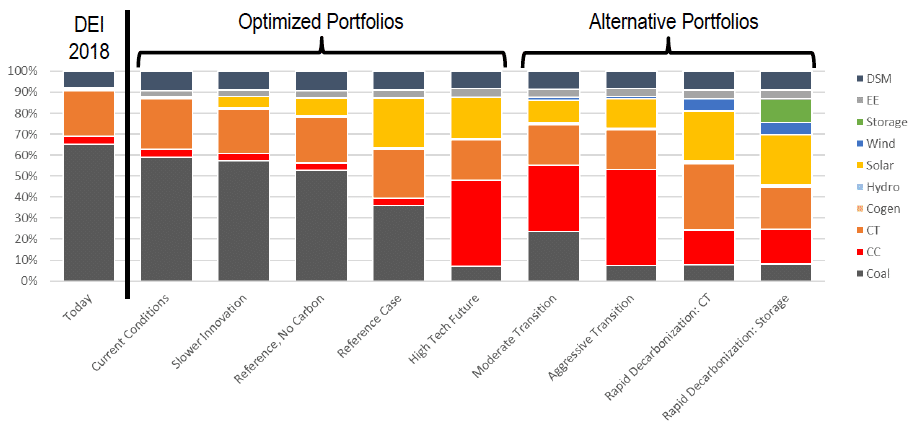While the U.S. utility sector was largely opposed to the deployment of renewable energy five or ten years ago, a number of leading utilities have changed their tune in recent years, and are choosing to embrace the future instead of fighting it.
This includes Xcel Energy, which has set a 2050 target for full decarbonization of its fleet, Avista which has set a 2045 target and Public Service Company of New Mexico which has a 2040 goal. In all cases these utilities serve states where mandates had either passed or were pending, but that can’t be said of Florida Power & Light, which plans to deploy more than 10 GW of solar by 2030, or of Consumer’s Energy, which plans to add 5 GW of solar by 2030 – in Michigan, no less.
And then there is Duke.
Duke talks a good fight, and there is never a shortage of announcements from the power company’s PR department about their deployment of renewable energy and energy storage. Duke would even like to take credit for the rapid deployment of large-scale solar in North Carolina. The reality is that Duke fought the policy that enabled the deployment of that solar, tooth and nail. And following Duke disabling PURPA, the solar market in North Carolina has significantly contracted.
Duke’s latest long-term resource plan for Duke Energy Indiana (DEI) is more foot-dragging and stalling from a company that has shown that it will do just about anything to keep its coal and nuclear plants online as long as possible, cost be damned. A series of slides published by DEI shows plans to keep coal and gas supplying more than 70% of the power to its customers as late as 2037 (the “moderate transition” scenario), and to deploy less than 100 MW of solar per year by this date.

These slides were presented in advance of DEI’s latest Integrated Resource Plan, which regulators have allowed the utility to delay twice, and which is now due by July 1. As part of the plan, Duke also plans to put two massive combined cycle gas plants online in 2028 and 2034.
Coal delays
One of the more interesting aspects of Duke’s plan is that it delays the retirement of existing coal plants, while new studies are showing that building new wind and solar is in most cases cheaper than even running existing coal plants, and while more and more utilities announce plans to get out of burning coal as a source of power entirely.
This includes neighboring Indiana utility NIPSCO, which plans to shut down all of its coal-fired power plants by 2028, due to the high costs of keeping these plants operating.
Duke also plans to shutter 1.9 GW of coal over the period of the IRP, but the timeline is notable. The company plans to shutter units 2 and 4 of its Gallagher coal plant in 2023, and take one unit out of its Gibson plant in 2026, but these two only represent 900 MW of capacity. The other retirements would wait until 2028 or later.

In defending this, Duke states that “Retiring one of the larger coal units, in general, will require long lead time transmission upgrades that will depend upon the specific unit retiring as well as other retirement and additions across MISO.” However, with so many large-scale solar projects seeking interconnection in the MISO queue that the grid operator is having to upgrade its review and approval procedures, lack of available capacity is an odd defense.
Cost for whom?
This is also in contrast to DEI’s plans to add no solar until 2023, meaning that it will not take advantage of the declining schedule of the Investment Tax Credit (ITC) to lower the cost of building new solar.
If Duke is deliberately avoiding reducing costs for its customers via renewable energy, this may be because the concerns of its shareholders are what is driving decisions. Ben Inskeep, a senior analyst at EQ Research, was on Duke’s call accompanying the presentation and made some observations about how the utility is framing its decisions.
Now talking about "reducing risk." For those not in the biz, "reducing risk" means relying on using their own power plants even if market purchases offer a significantly better deal for its customers. (Utilities only get a profit on building assets – not buying power.)
— Ben Inskeep (@Ben_Inskeep) June 20, 2019
Inskeep further argues that these decisions show that if left to its own devices, Duke will continue to choose a path that is damning for future generations.
Reading between the lines, it sounds like Duke is saying they acknowledge the geophysical reality, but they have a fiduciary responsibility to continue operating their business in a way that accelerates climate crisis since they aren't being legally forced to stop.
— Ben Inskeep (@Ben_Inskeep) June 20, 2019
And given the cost advantages that Duke is ignoring, the utility may be willing to make its customers foot the bill for these decisions in more ways than one.
This content is protected by copyright and may not be reused. If you want to cooperate with us and would like to reuse some of our content, please contact: editors@pv-magazine.com.









Duke is one of those ‘players’ in the electric utility industry that shows two faces. On the East coast, Duke pushes more natural gas infrastructure and keeping ‘fueled’ generation online. On the West coast, Duke has bought a couple of alternative energy developments to ‘insert’ themselves into the regional utility’s sphere of influence by selling non-fueled power to the ratepayers of that utility’s revenue base.
Duke apparently hasn’t realized and seemingly neither has XCEL, that the recent ACE edict for energy generation really hasn’t slowed down the demise of fossil fueled generation assets. This just changes the level of the law suits filed against utilities will come from the State level instead of the Federal level. Different States, different ‘mandates’ different rules and regulations, yeah, it’s gong to get real interesting trying to “do business as usual”.
From the article the bottom line: “And given the cost advantages that Duke is ignoring, the utility may be willing to make its customers foot the bill for these decisions in more ways than one.”